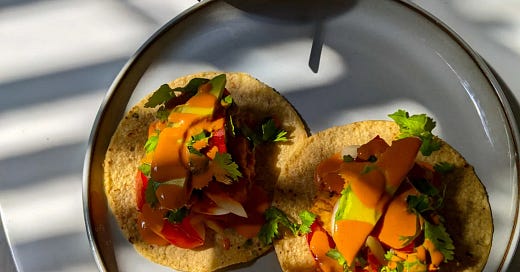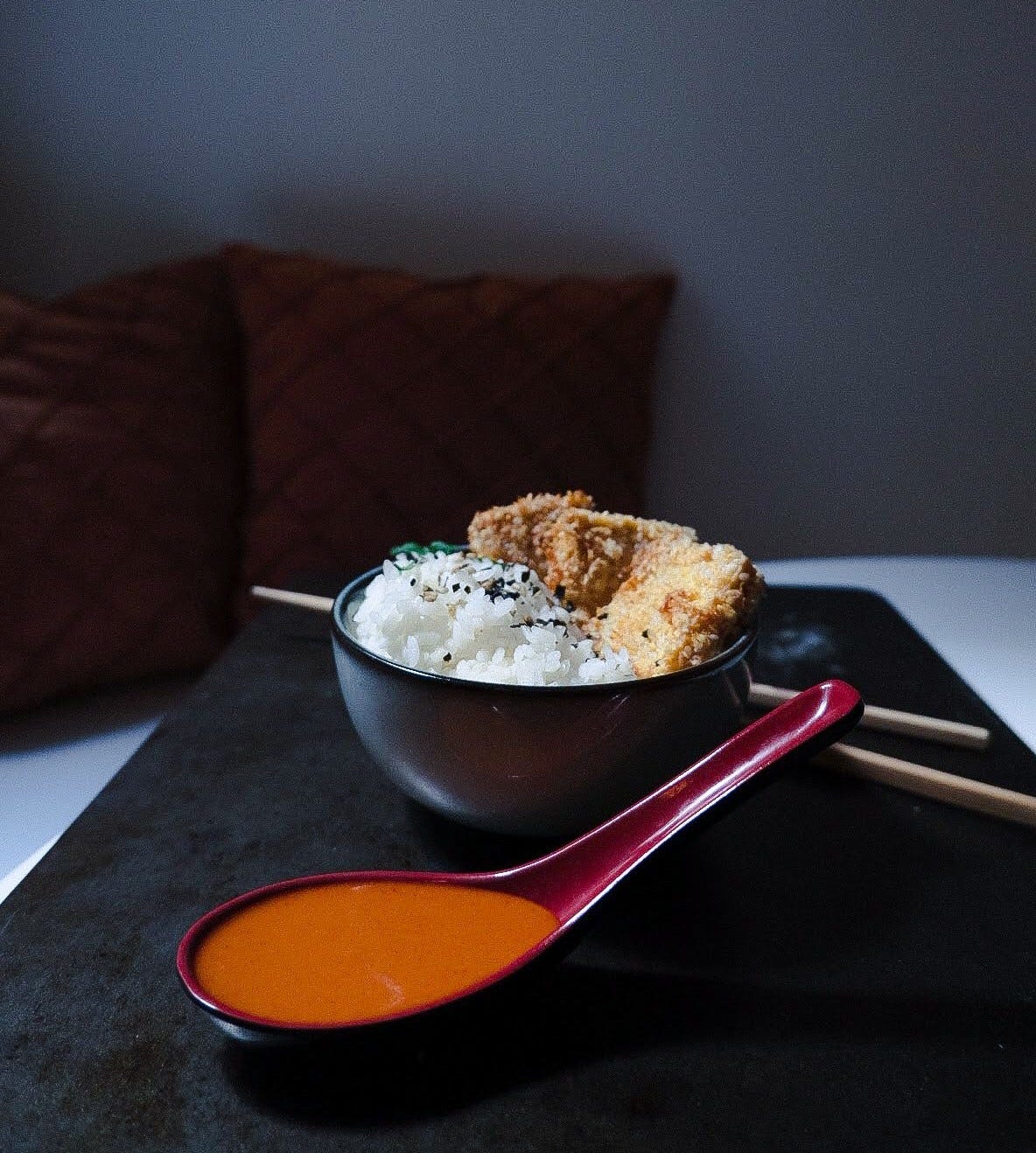It's A Sauce, It's A Marinade…It's Spicy Tahini Dip! - No. 3
And various dishes I used it for this week.
Hello and welcome back to Vegarie. Does it feel like I've promised you something and haven't delivered? Does it vaguely remind you of your childhood…No? That’s just me? Ok, well, it's accurate. I've been talking about this spicy tahini dip since early last week and while I'd like to lie and say I've just been sweating in the kitchen to refine it, I haven't. Life has gotten away from me in other mostly productive ways all week. Alas! Time is a construct and I'm finally delivering the goods. IE, my dip. Along with the various dishes I've been using it on this week to give you inspiration for your busy week ahead. Before I dive head first into this pool of creamy, spicy, garlicy goodness—I'd like to remind you that if you've made your way here by some miracle and still aren't subscribed to my newsletter, it's not too late. Press the button below, drop your email in ze little box and be the first to receive recipes, tips, tricks, hilarious puns…every Friday.
Anyway, thanks for being here, for opening my email and not flagging me as spam…for fawning over my bright red gochujang drizzle (pictured below) and not ragging on me for the amateur shutter speed settings. Yes—for those of you who don't know, I'm teaching myself techniques for becoming a food photographer, cookbook writer and developer, THE DREAM. And well, when my head hits the pillow at night, I do dream, but dimensional travel is still being developed and this takes time…science. Since I'm at a lack of time this week for reasons I will not be able to confidently share until next week—YES, it's a teaser to subscribe for a fun announcement about my personal life—I will try to be quick and to the point.
A unlikely blend of Korean and Middle Eastern influences here, I've whipped up a concoction of creamy tahini, garlic, and gochujang. A lot of you that know me, know that I have an obsession with tahini and use it in nearly all of my sauces, dressings, and dips. It’s my default for a reason, it’s creamy, blends well with a lot of other flavors, and adds a edge of bitterness that other nut butters just do not. But I’ll tell you why I used it here, because it’s no accident and it’s not just because it’s my default. Tahini, for those who haven’t used it before, is a paste made from sesame seeds, and it’s commonly known for being a main ingredient in hummus, but it’s also used in many dishes in place of butter or a nut butter, or even as a fresh drizzle in Australian, Middle Eastern, and so many other cooking styles. I used it in this dip because sesame is also very common in Asian dishes and I think the bitterness from the sesame seed compliments the spice and bite that you get from a fermented paste like gochujang. So, next you may be asking, "what exactly is gochujang?" To which I would respond, "if you don't know, you're surely missing out." No really, go buy some now.
The real answer is in its name: gochu means chili, while jang translates to fermented sauce or paste. It’s a fermented chili paste widely used in Korean cuisine. A star in a lot of dishes including soondubu jjigae (a soft tofu stew), dak-twigim (korean fried chicken), and my favorite; tteokbokki (a popular korean street food with fried rice cakes, a heavy coating of gochujang sauce and different toppings like cheese curds, or fish cakes, depending on the neighborhood). Trust me, it’s delish. The classic Korean paste is a labor of love, fermenting red peppers, glutinous rice, salt, and soybeans for 1-2 years before packaging. You can find it at most Asian markets, but honestly it's becoming widely used and you can even find it at Wholefoods now. But not all brands are of the same quality; newer versions cut corners on the fermentation process and use additional ingredients like garlic, sugar, and other aromatics to make up for the difference or lack of bite. I know, capitalism, blah blah, but I think it's cool that Korean food is becoming so popular in general.
If you haven’t tried it, you might be thinking how special is it really, and what sets gochujang apart from other spicy sauces? Well, gochujang has a bold salty, pungent, spicy, and slightly sweet flavor with a distinct funky taste. This is mainly due to the fermentation process that I talked about above which makes it very unique indeed. Now, Koreans may roll their eyes at the way I used this sauce in my day to day cooking, but here are some dishes I created using my dip!
This Week’s Meals
Drizzled over rice (plus a dash of furikake) and this crispy tofu, with or without veggies and kimchi
Over tacos for a garlicy kick; pictured above with avocado, tomato, cilantro, leftover shredded chicken
It thickened in my fridge through the week, because tahini is quite absorbent. I used the thicker version as a dip for carrots and peppers I got from work (thanks produce guy at Talea!)
As a marinade for my crispy tofu experiment—a round two of the crisp tofu recipe I linked above, but instead of egg, I used my tahini sauce as the batter to get the panko bread crumbs to cling on for dear life. It was actually really good so I’ll leave my notes and break down below to dip recipe in case you want to try — it makes the crisp tofu recipe vegan!
What will you use yours in this week? I want to hear about it, leave me a comment.
Spicy Tahini Dip
Yields about 1 1/2 cups of sauce. Double or triple the batch if you are cool.
Ingredients:
1/3 cup + 1 tbs tahini
2 tbs gochujang
2 cloves garlic (minced tiny)
1 tbs soy sauce
1 tbs rice vinegar (or any neutral vinegar you have on hand)
1/2 tbs honey (optional, although recommended)
1/2 cup water
Preparation:
Mince your cloves of garlic real small. Stir all ingredients together to combine. It’s that simple ;) Personalize it: add more garlic if you’re into a sharper flavor (to be honest, I like 3 cloves!), more than 2 tbs of gochujang if you like it spicy, or 1 tbs honey if the gochujang is too spicy.
Store in the fridge in an air-tight container. As it cools, it’s natural that the dip will thicken because the tahini is really absorbent. Either keep it thick and use it like spread on a sandwich or toast, or add a little extra water each time you use to thin it out and use like a dressing, sauce, or marinade.
Using As A Marinade for Crispy Tofu
Ingredients:
1(12-ounce) package extra-firm tofu, cut into 16 equal (or unequal — why reform?!) rectangles
1/2 cup panko bread crumbs (or ¼ cup cornstarch, for gluten-free peeps)
1/8 cup white sesame seeds
Salt to taste
1/3 cup of my sauce (above!!)
1/4 cup neutral oil, such as grapeseed, for pan-frying — or use an air fryer like I did and you won’t need any oil at all
Preparation:
Cut your extra-firm tofu into about 16 cubes. Place in a container (preferably glass because environment) and cover the tofu with 1/3 cup of my spicy tahini sauce. Maybe toss it around a little to make sure everything is evenly coated. Let sit for at least 1 hour, but it’s even better if you wait overnight and let the tofu soak up the flavor a bit more.
Combine your dry ingredients into one medium bowl — that’s the panko bread crumbs, sesame seeds, salt.
When ready to cook, simply dip the saucy tofu into the panko crumb mixture and evenly coat all around. Pan fry or air fry until golden brown. YUM!
Thank you again for reading Vegarie. You’re each special little gems, worthy of years and years of love…like the fermented chilis in gochujang.






